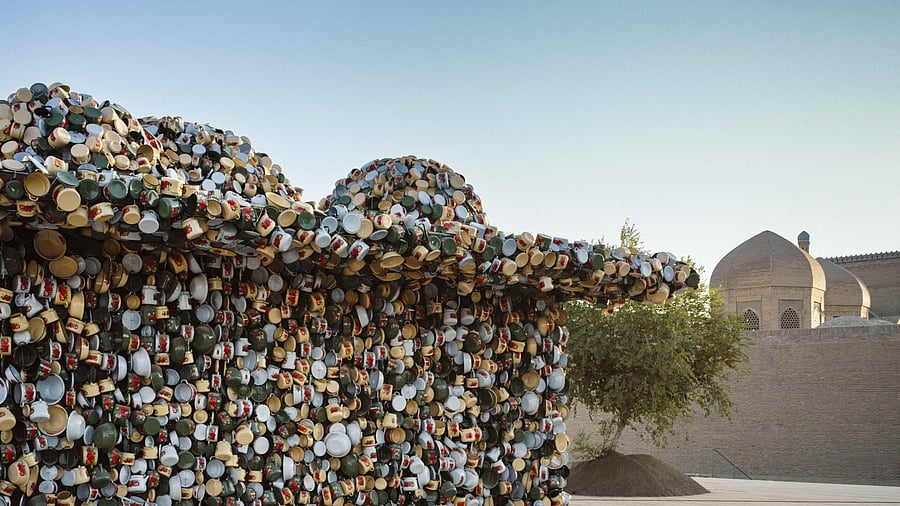
Salt Carried by the Wind
Credit: Subodh Gupta
In the heart of Bukhara, once a bustling Silk Road hub linking India and Central Asia, artist Subodh Gupta has built a kitchen that is also a monument. Salt Carried by the Wind, his domed pavilion of enamelware and ceramics, rises amid restored madrasas and caravanserais, part of the inaugural 2025 Bukhara Biennial (September 5-November 20) — touted to be Central Asia’s largest contemporary art platform.
Long remaining distant from the world’s major art circuits, in recent years, Uzbekistan has begun stepping onto the global stage. Despite its geographical isolation, a surge of cultural activity — from new institutions to international events — is rapidly transforming Uzbekistan from a little-known outpost into a rising centre of artistic exchange.
At the core of this transformation are state-led efforts such as the establishment of the Centre for Contemporary Arts (CCA) in Tashkent, the inauguration of the Bukhara Biennial, and an expanding roster of programs aimed at youth and traditional crafts. Together, these initiatives highlight a dual ambition: to preserve and celebrate the nation’s rich heritage while creating platforms for contemporary creativity.
The Bukhara Biennial itself — staged across restored madrasas, caravanserais, and domes in the city’s old town — provides the perfect backdrop. It brings together over 80 international and regional artists, positioning Bukhara, long a Silk Road hub, as a new epicentre of creative exchange. Under the CCA, the Biennial has a lineup of Central Asian and international participants from 39 countries showcasing site-specific artworks and installations — all newly commissioned and made in Uzbekistan — as well as events, performances, scholarly programs, poetry, and culinary activations.
As I navigate the maze of works, it’s clear that the CCA’s mission goes beyond curation: they are amplifying local voices, connecting them to global dialogues, and transforming heritage sites into living, experimental hubs for contemporary creativity.
“Central Asia is seen as a blank space on the contemporary art map. With Bukhara, we want to show the world that our heritage is alive, evolving, and part of global conversations. By bringing together local and international artists, we have created a dialogue that celebrates tradition while embracing experimentation,” Gayane Umerova, co-curator of the Bukhara Biennial, reflected on the event’s significance.
In keeping with this overarching vision, Gupta’s food-filled installation turns history into a shared, edible experience, tracing centuries of trade, spice, and cultural exchange while staging a conversation between Indian and Uzbek traditions.
In Bukhara, art and heritage converge, and salt — humble, universal, and infinitely migratory — becomes both metaphor and medium, seasoning memory itself. The installation is performative as much as sculptural. At intervals across the biennial, Gupta steps into the pavilion and cooks at a pop-up for a select international audience, turning his kitchen into a stage and the act of feeding into a collective rite.
These meals — hybrid recipes that nod to Indian spice and Uzbek pilaf, to samsa and samosa — stage exchanges that are literal (recipes, ingredients, ceramic forms) and symbolic (hospitality as diplomacy, the domestic as international). “I always believe the kitchen is the most democratic space,” says Gupta. “Around a table, differences collapse — food is the language we all speak.”
“Salt is simple,” Gupta says, “but it is also history, survival, migration. It is the one element that unites kitchens from India to Uzbekistan.” The pavilion’s enamel exterior — borrowed from Soviet-era mass-produced kitchenware common in Uzbek homes — makes visible a lineage of material culture that has travelled east and west along the very routes that once carried spices, grains, and ceramics between India and Central Asia. Inside, suspended ceramic plates and hand-thrown tableware created with award-winning Uzbek master ceramist Baxtiyor Nazirov suggest that objects can carry memory as much as they carry food.
“When Subodh first spoke about salt as a travelling element, I immediately thought of the clay and ceramics that have moved along these same routes for centuries. Every plate and bowl carries stories — of families, of kitchens, of trade. Working together, we tried to make the objects speak, not just hold food, but hold memory. It’s a dialogue between our traditions and a way to honour the past while creating something new,” Nazirov reflected.
Collaboration underpins the work. The co-creation with Nazirov — and with local chefs and artisans — folds Indian and Uzbek traditions into one another. The enamel dome references a shared vernacular of household implements, while the bespoke interior ceramics are crafted in workshops where hands know glaze like language.
Mounting such a work in Bukhara was not without challenges. The city’s restored historic fabric demanded sensitivity; every nail and ceramic had to negotiate conservation protocols and strict site rules.
Practical hurdles mattered too: shipping materials across borders, sourcing locally while respecting traditional workshops, and coordinating performances in venues centuries old. Gupta admits the challenges were formidable: “When you work with living heritage, you cannot force your way in. You have to listen to the space, respect its rhythm, and then find your place within it.”